Freight Locomotives and Trains
28 February 2012 23:34 Filed in: Model Trains
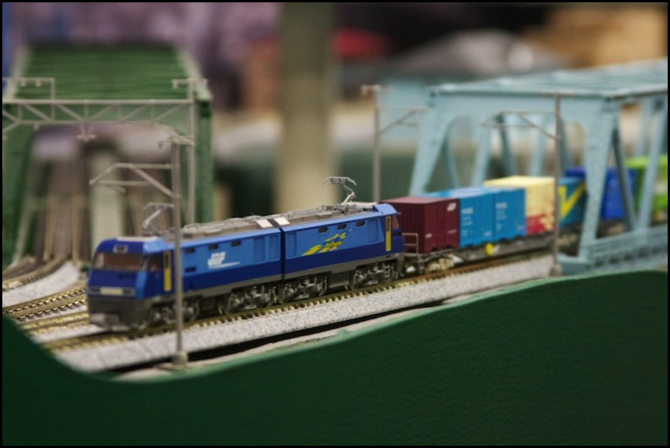
I’ve written about my model freight trains before, but that was nearly two years ago, and I think it’s time for an update. This time I’m going to talk about the trains, as well as the locomotives. As usual, the focus of my collecting is the area around Tōkyō, and thus the trains found there are what I am writing about.
Freight locomotives in the Tōkyō area tend to be electric. There are exceptions: in addition to switching duties, the diesel-hydraulic DE10 can sometimes be found moving short trains. One example of this is the coal train I’ll describe further down below. But for the most part these trains are operating over lines already electrified for passenger trains, and so it makes more sense to use electric locomotives.
When JR Freight (JRF) was formed in 1987, it inherited a number of older electric locomotives used for freight, and continues to use many of them to this day. In fact, it even built some more of these models in its first few years to meet demand. But it also began developing more modern ones, suited to efficiently hauling the specialized trains it now had. I have a couple of models of the older ones (an EF65 and an EF66), but my focus is on the new JRF designs.
Freight trains in Japan are definitely secondary to passenger trains on almost all lines. There are a few specialized lines, serving industrial areas mostly, that are freight-only or dominated by freight. But in most cases, heavy cargo can move by sea, and light cargo can move by truck, and there just isn’t much left for the trains. A couple of years before it was broken up, Japan National Railways (JNR) shut down its carload freight classification yards. Today its successor for freight, JRF, operates specialized yards for container trains and similar, and operates to and from private sidings at large industries (e.g., moving a unit train of auto parts for Toyota, as an example) but largely operates over rails owned by the various JR passenger companies.
Freight trains in Japan tend to be short by western standards. A typical train will be perhaps two-dozen cars long, and many are shorter. The majority of these are unit trains, trains formed of a single type of freight car. Cargo containers on specialized flat cars, as seen behind an EH200 above, are one of the most common. There are, however, a small number of mixed trains still observed from time to time. Exactly how the latter come about without classification yards isn’t clear to me.
Freight trains also have to fit in with passenger train schedules, so fast-moving trains are more common than they are in other parts of the world. This may be another reason the trains are kept short.
Japanese domestic containers are relatively small; the common 19 series container stands 2.5m (8.2’) tall has an interior dimension of approximately 19 cubic meters (671 cubic feet), and has a capacity of 5 tons (metric tons, 5,000 kg), and are sized to fit on a small delivery truck. Normally five of these are loaded on a flat car, so the entire train is pulling only 120 of them. I have quite a large set of these (see the Freight Cars photo album), mainly made by Tomix, along with Kato and Tomix flat cars of the modern KoKi 104 and 106 series. In fact, I have enough to make a prototypical-length 24-car train if I wanted. But I think I’d normally run about 12-16 to keep it more reasonably sized for the layout.
The EH500 seen above is an eight-axle, 4,520kW (6000 hp) locomotive with a top speed of 110 kph (68 mph). Although built for use on DC-powered lines, it uses AC traction motors, which is typical of newer designs as these motors are much more efficient. Wikipedia says these are used for oil trains north of Tōkyō and on the Chūō line west of the city. I’ve seen numerous photos of them pulling container trains also. According to Wikipedia 21 had been built through 2009, making it a relatively small class.
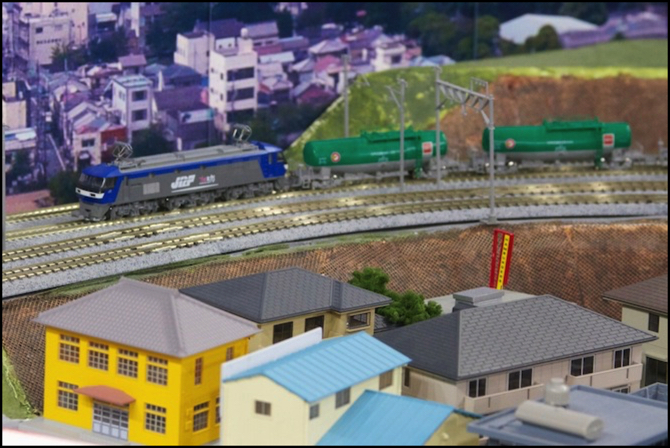
EF210 Pulling a string of oil tank cars
The EF210 is a six-axle, 3,390kW (4,546 hp) locomotive with a top speed of 110 kph. Like the EH500 it is built for DC lines, but uses AC traction motors. As of 2010 73 had been built. Photos show it pulling both oil and container trains. I have enough Kato TaKi 1000 oil tank cars to make a 16-car train.
One of the trains typically pulled by the EF210 is the Toyota Longpass Express (Japanese Wikipedia), a unit train of 20 container cars carrying auto parts, which operates in overnight express service at speeds up to 100 kph (62 mph) between Nagoya in western Japan and Morioka in northern Japan, a distance of perhaps 1,000 km covered in 15-20 hours. An EH500 is used on the northern portion of the route, where AC power is required.
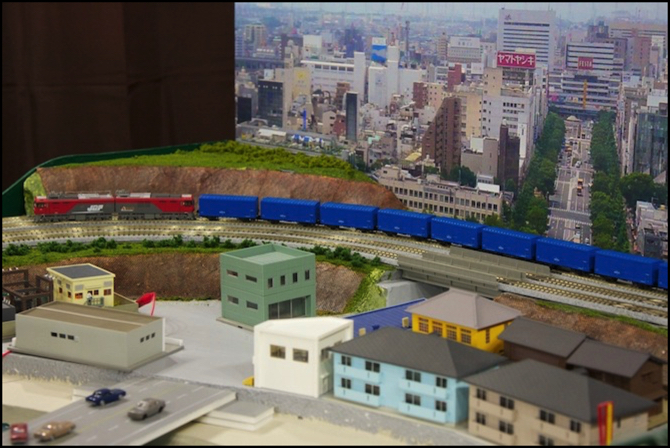
EH500 with WaMu Boxcars
The EH500 is an eight-axle, 4,000kW (5,364 hp) locomotive with a top speed of 110 kph. This is a dual-voltage locomotive, allowing it to operate on lines north of Tōkyō that have both DC and AC sections. As with the other modern trains, this uses AC traction motors. While these locomotives are sometimes taken off north of the city (see the comment above about the express train), they do operate into Tōkyō as well. These would most likely be found hauling container trains.
While it’s unlikely you’d find one hauling a string of WaMu 380000 boxcars, it’s not completely impossible. Although quite old, the blue ones were updated in the 1990s with roller bearings, and used until recently to transport paper. However, Japanese Wikipedia reports that as of the March 2012 timetable, all use of these will be abolished. Some few remain for maintenance and wreck response uses, but the days of unit boxcar trains are over. I, however, have sixteen of Kato’s version of these, and can happily live a little bit in the past.
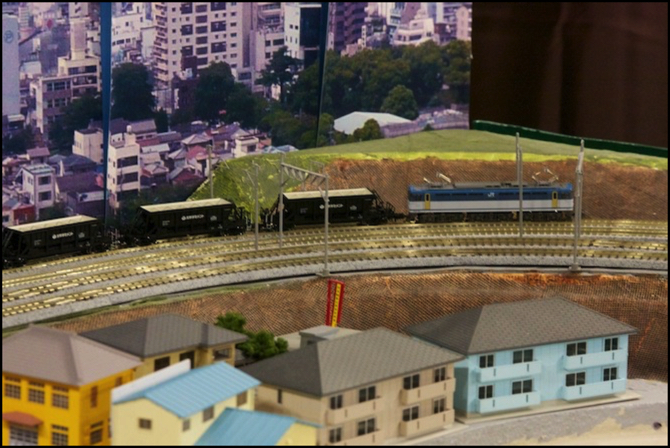
EF65 and Coal Cars
The EF65 seen above isn’t a modern locomotive, but it is a representation of a current train. The HoKi 10000 is a 35-ton, bottom-dump hopper car used mainly to transport coal. And in particular, to transport it from a coal dock on the Tōkyō waterfront to an inland concrete plant that operates its own coal-fired power plant. The cars are pulled from the waterfront by DE10 locomotives, as the dock is not electrified, but then they are formed into unit trains of 20 cars, and typically hauled by EF65 locomotives, like this one. I have a number of these coal cars, made by Kawai.
The EF65 is one of the freight locomotives inherited by JR Freight. Originally 308 were produced, and 95 remain in service. This is a six-axle, 2,550kW (3,420 hp) locomotive designed for use on DC lines at up to 110kph, but unlike the more modern designs it uses DC traction motors, so pulling power is less. Photos show them pulling unit trains of containers, tank cars and blue boxcars.
I own several DE10s as well, but don’t really have a good excuse to use them pulling trains. Someday perhaps I’ll add a port facility for my freight to play on.
I also own an EF66, and JR Freight owned 63 of these 3,900kW (5230 hp) locomotives as of 2009, but apparently they are all based out of Osaka. They, too, are DC-powered, DC-motored, and have a top speed of 110 kph. The original design was part of JNRs push into express freight, and the goal (per Wikipedia) was to pull a 1,000 metric ton train at 100 kph. JRF actually bought more of these in 1989 (the design dates from 1968).
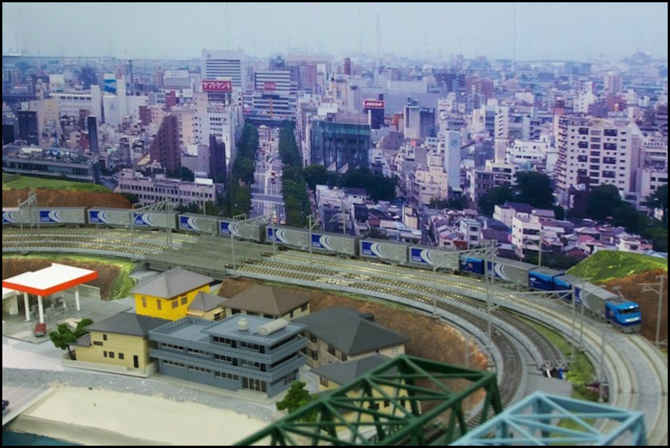
M250 Super Rail Cargo
Finally, one of the most distinctive of Japanese freight trains, and one of my favorite models, Kato’s version of the M250 Series Super Rail Cargo freight EMU. Instead of a locomotive, it has a pair of power cars at each end of the sixteen-car train, each power car holding one thirty-one-foot container, and the other twelve cars holding two each. There are two trains, and they operate in alternating service between Tōkyō and Osaka.
The M250 is rated at 3,520kW (4,720 hp) and operates over DC-powered lines at speeds up to 130 kph (81 mph). It carries containers belonging to an express small-package freight company.
And those are my freight trains, at least for now. There are a few models I don’t have, and a number of less common freight cars I really ought to get a few of, just to create the occasional mixed-freight train. But with these I’ve covered the bases as far as typical trains go, and can mix one in with my passenger trains in prototypical fashion from time to time.



